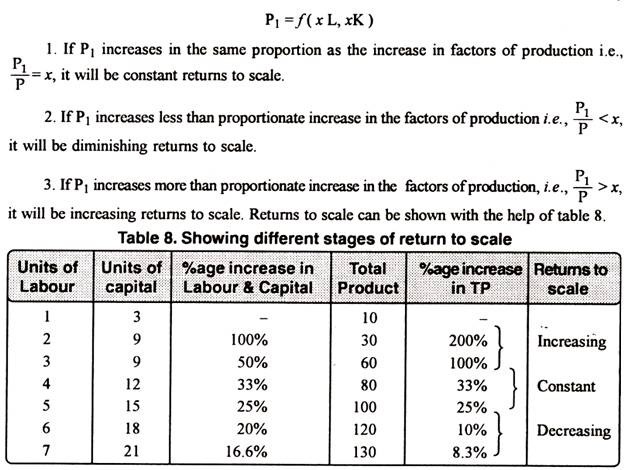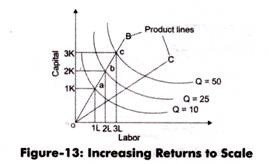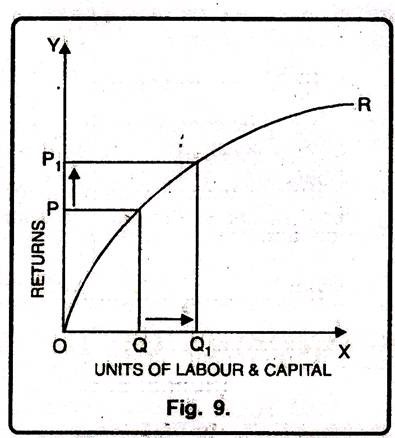Explain the Different Types of Returns to Scale
Constant returns to scale prevail ie by doubling all inputs we get twice as much output. When increasing returns to scale occurs it results in economies of scale.

Law Of Returns To Scale Definition Explanation And Its Types
This relationship is shown by the first expression above.

. 5 Major Differences between Returns to Scale and Returns to a factor Proportions are listed below. Increasing returns to scale constant returns to scale and diminishing or decreasing returns to scale. When the change in output is more than in proportion to the equi-proportional change in.
If ab. Q 5 Km Lm 5KLm 2 Q m 2. Constant Returns to Scale.
When all inputs are increased by a certain percentage the output increases by the same percentage the production function is said to exhibit constant returns to scale. Returns to scale are long-run measurements. When all inputs are increased by a given proportion and the output increases by less than that proportion it is called decreasing returns to scale.
If the proportional change in the output of an organization is greater than the. For ab1 we get constant returns to scale. Again we increase both K and L by m and.
B Decreasing Returns to Scale. When a proportionate increase in all inputs results in the rise in output by the larger proportion. Diminishing Returns to Scale.
Our new production has increased by more than m so we have increasing returns to scale. Decreasing Returns to Scale. There are three defined types of returns to scales which include.
Solved Example Cobb Douglas Production Function. Increasing Returns to Scale. If ab1 there are increasing returns to scale.
For example in this scale 100 increase in inputs increases the output exactly by 100. Content Production function and Isoquant Isoquant or Iso-product map MRTS Returns to Scale 3. Constant Returns to Scale ADVERTISEMENTS.
The advantage arises due to the inverse relationship between per-unit fixed cost and the quantity produced. As a result we have constant returns to scale. In this scale one percentage increase in inputs increases the output by exactly one percentage point.
The greater the quantity of output produced the lower the per-unit fixed cost. ISOQUANTS AND RETURNS TO SCALE PRESENTED BY-KARTIKEYA KARTIKEYA SINGH KRISHNAVATAR KSHITIJ 2. In case it triples output.
Constant returns to scale CRS increasing returns to scale IRS and decreasing returns to scale DRS. The Cobb Douglas production function Q L KA LbKa exhibits the three types of returns. Long run or long term refers to a period of a time within a company when their production factors are variable.
The production is said to generate constant returns to scale when the proportionate change. Increasing Returns to scale. One special case in the long run happens when both the factors are raised by the same amount of factors are ascended up.
For example if all inputs are increased by three times and yet output gets only doubled then that kind of input-output relationship is referred to as decreasing returns to scale. There are three possible types of returns to scale. Constant Returns to Scale.
Only one factor varies while all the rest are fixed. Increasing Returns to Scale. Decreasing Returns to Scale.
A constant return of scale is an economic condition where a companys inputs like capital and labor increase at the same rate as their outputs or value of their goods. The advantage arises due to the inverse relationship between. Three phases of returns to scale There are three phases of returns in the long-run which may be separately described as 1 the law of increasing returns 2 the law of constant returns and 3 the law of decreasing returns.
There are three kinds of returns to scale. Since m 1 then m 2 m. Economies of scale refer to the cost advantage experienced by a firm when it increases its level of output.
When a proportionate increase in all inputs results in the rise in output by the same proportion the production function is said to exhibit Constant returns to scale CRS. Constant Returns to Scale Constant returns to scale occur when a firms output exactly scales in comparison to its inputs. A constant returns to scale is when an increase.
Returns to scale in economics the quantitative change in output of a firm or industry resulting from a proportionate increase in all inputs. Technology exhibits increasing decreasing or constant returns to scale. Formally a function that is homogeneous of degree one or FcxcFx for all c 0.
Increasing returns to scale decreasing returns to scale and constant returns to scale. Returns to a factor. When the output of a firm increases in the same proportion in which the.
Increasing Returns to Scale. If the quantity of output rises by a greater proportioneg if output increases by 25 times in response to a doubling of all inputsthe production process is said to exhibit increasing returns to scale. If there is equal percentage increasechange in inputs and output then the production scale is known as constant returns to scale.
Fixed and Variable Costs Cost is something that. Diminishing Returns to Scale. The factor-proportion varies as more and more of the units of the variable factor are employed to.
For example if a firm doubles inputs it doubles output. For example a firm exhibits constant returns to scale if its output exactly doubles when all of its inputs are doubled. If we multiply all inputs by two but get more than twice the output our production.
2 Constant Returns to Scale Definition and Example. Again we increase both K and L by m and create a new production function. The three possible outcomes are.
Returns to a factor. Returns to scale are of the following three types. If output increases by the same proportional change as all inputs change then there are constant returns to scale CRS.
Increasing Returns to Scale.

Law Of Returns To Scale Definition Explanation And Its Types

Law Of Return To Scale And It S Types With Diagram

Law Of Returns To Scale Definition Explanation And Its Types

Returns To Scale Motivation Theory What Is Marketing Law Of Return
Comments
Post a Comment